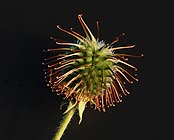
Biomimetics or biomimicry is the emulation of the models, systems, and elements of nature for the purpose of solving complex human problems.[2][3][4] The terms "biomimetics" and "biomimicry" are derived from Ancient Greek: βίος (bios), life, and μίμησις (mīmēsis), imitation, from μιμεῖσθαι (mīmeisthai), to imitate, from μῖμος (mimos), actor. A closely related field is bionics.[5]
Nature has gone through evolution over the 3.8 billion years since life is estimated to have appeared on the Earth.[6] It has evolved species with high performance using commonly found materials. Surfaces of solids interact with other surfaces and the environment and derive the properties of materials. Biological materials are highly organized from the molecular to the nano-, micro-, and macroscales, often in a hierarchical manner with intricate nanoarchitecture that ultimately makes up a myriad of different functional elements.[7] Properties of materials and surfaces result from a complex interplay between surface structure and morphology and physical and chemical properties. Many materials, surfaces, and objects in general provide multifunctionality.
Various materials, structures, and devices have been fabricated for commercial interest by engineers, material scientists, chemists, and biologists, and for beauty, structure, and design by artists and architects. Nature has solved engineering problems such as self-healing abilities, environmental exposure tolerance and resistance, hydrophobicity, self-assembly, and harnessing solar energy. Economic impact of bioinspired materials and surfaces is significant, on the order of several hundred billion dollars per year worldwide.
- ^ Jennifer L. Hellier, ed. (2015). The brain, the nervous system, and their diseases. Santa Barbara, California. ISBN 978-1-61069-337-0. OCLC 880809097.
{{cite book}}: CS1 maint: location missing publisher (link) - ^ Cite error: The named reference
:6was invoked but never defined (see the help page). - ^ Vincent, Julian F. V.; et al. (22 August 2006). "Biomimetics: its practice and theory". Journal of the Royal Society Interface. 3 (9): 471–482. doi:10.1098/rsif.2006.0127. PMC 1664643. PMID 16849244.
- ^ Cite error: The named reference
:5was invoked but never defined (see the help page). - ^ Cite error: The named reference
McCartywas invoked but never defined (see the help page). - ^ Gordon, J. E. The New Science of Strong Materials, or Why You Don't Fall Through the Floor (2nd ed.). London, U. K.: Pelican–Penguin.
- ^ Alberts, B; Johnson, A.; Lewis, J.; Raff, M.; Roberts, K.; Walter, P. (2008). Molecular Biology of the Cell. New York: Garland Science.

